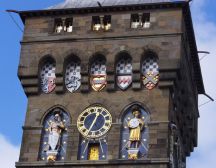
Launch of Cardiff treasure hunt
Treasuredays has today launched its latest new hunt. Our Cardiff treasure hunt starts at Central Station and follows an almost circular route through central Cardiff, taking in St. David's Cathedral, Cardiff Castle and the Millennium Stadium.
Cardiff Castle - Cardiff treasure hunt
One of the highlights on the route of this treasure hunt is Cardiff Castle. On the site of a Roman fort, the Castle was originally built by the Normans in the 11th century. During the Civil War, a Parliamentary force captured it by sneaking through a secret passageway.
The Castle saw major refurbishments in the second half of the 19th century, when it was owned by John Crichton-Stuart, the 3rd Marquess of Bute. The first of these was the 150 foot clock tower, which included the Summer and Winter smoking rooms. It was based on part of the design that architect William Burges has submitted for the Royal Courts of Justice in London.
But the most unusual of Bute's additions is the Animal Wall, also designed by Burges and completed by Thomas Nichols. It originally stood right in front of the Castle, but was moved to its present location outside Bute Park when Duke and Castle Streets were widened in 1922. Six new animals were added in 1931, while a restoration in 2010 saw the replacement of the missing glass eyes of the original animals as well as the anteater's broken snout.
Millennium Stadium - Cardiff treasure hunt
Another magnificent sight on the treasure hunt route is the Millennium Stadium in Westgate Street. With a capacity of 74,500, it is the second largest stadium in the world with a fully retractable roof.
Outside stands a statue of a little-known but a remarkable man. As a lawyer, Sir Tasker Watkins rose to be Deputy Chief Justice of England and Wales, and was then President of the Welsh Rugby Union during the transition to professionalism and the building of the new stadium. He also held a Victoria Cross, which he won as a lieutenant during the Second World War. As the only officer left, he first led his company in a bayonet charge to almost wipe out a larger enemy force, and later the same day he single-handedly charged and silenced an enemy machine-gun post.
Other News
- Launch of Stratford treasure hunt - 02/11/17
- Launch of Edinburgh Old and New Town treasure hunts - 02/08/16
- Launch of Bristol treasure hunt - 22/10/15
- Launch of Canary Wharf: Docklands treasure hunt - 18/05/15
- Launch of Cardiff treasure hunt - 29/03/15
- Launch of Glasgow treasure hunt - 19/09/14



